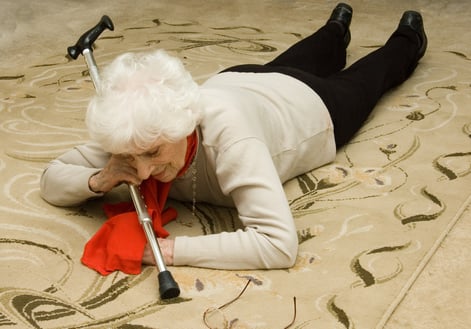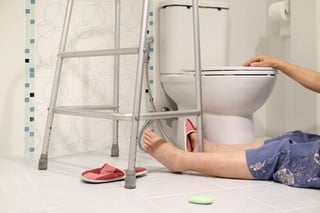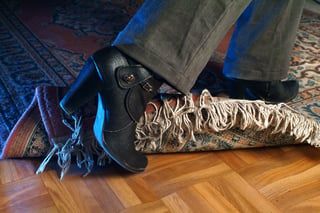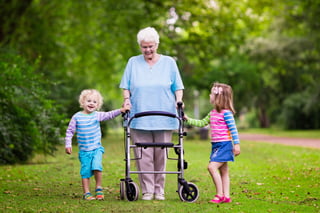this blog post was updated on 05/03/2019

Among the elderly, falling is one of the leading causes of injury or permanent disability.
Many people list fear of falling as a substantial cause for anxiety and is often the reason some shy away from physical activity, Accidents do happen fall hazards can be reduced with some precautions.
The Numbers
Falling is the second leading cause of injury death after road accidents. This is a scary statistic.
A fall in the kitchen or bathroom could mean a permanent disability or even death. More than 30 million falls are severe enough to require medical attention each year.
In fact, one out of five falls lead to serious injury like a fracture. Falls are the most common cause for traumatic brain injuries.
This only emphasizes the need for fall prevention in the home.
Why Falls Happen
There is a host of things that could cause falls in the home. Medication and ill health are chief among them.
Another main cause is poor balance and lower body weakness. Vitamin D deficiency is also a factor as it causes weakness in the bones.
Structural problems like uneven surfaces or disproportionate stairs can trip anyone up very easily.
Some often ignored issues like loose tiles and carpeting are major hazards. Wet floors, poor lighting, and trailing electrical cables area also some common trip hazards.
Most incidents of falling are caused by a combination of factors. The aim here is to reduce the amount of risk in the home to leave it at negligible to nil.
Assessment of risk should be done first to determine the most problematic areas in the house.
One can begin with something as small as picking up their clothes and toys off the floor or just keeping the floor clear of wet spots.
Bathroom Safety
Grab bars
These are sturdy bars installed around the bathtub and toilet. They offer support when  getting up and out of the tub.
getting up and out of the tub.
One can also hold on to the bar when stepping out of the shower. These also offer convenient hold.
This comes in handy in preventing a slide from resulting in a fall.
They can also be installed elsewhere in the house as the occupants deem fit.
Mats
There are specially designed rags with rubber backing. These do not slide on the floor surface when stepped on.
Alternatively, one can use non-slip mats. These are made of a material that clings to the floor.
These can be placed in the bathrooms, kitchen and whatever other fall risky area.
Kitchen Safety
Convenient storage
The kitchen should be designed ergonomically.
This means that all the spices and stirring implements should be kept as close to the stove as possible.
The chopping board and knife should be close to each other while the coffee cups and coffee maker stay on one corner.
This ensures one does not have to move around too much while in the kitchen.
If one has to step on something to reach a top shelf, they should ensure to use a sturdy stepladder or stool.
If a chair is used, it should have armrests to hold on to when stepping up.
Cabinet doors should stay closed when not in use. They are major fall hazards in the kitchen as they are below the eye line.
Spills
A grease or liquid spill when stepped on can be fatal. One could fall and hit their head or break their hip.
Falling in the kitchen is more dangerous because on the way down, one might reach out and hold on to a hot pot of porridge of soup.
Instead of serving soup to dinner guests with effortless grace, you might find yourself wrapped in gauze and contained in a cast.
To avoid such freak accidents, spills should be wiped up as soon as they happen.
Serving Food
When serving food for any guests you may have, you may want to find a new way to serve food.
Instead of bringing the food out to the table for everyone, have the food set up buffet style so you are not risking falling and spilling food on yourself or others.
You can also invest in a bar cart that you can load with food and wheel over to the dining table, removing risk of falling and spilling.
Stair Safety
Many risks come with stairs. A staircase, while beautiful, is dangerous to the elderly and children. Avoid going up and down stairs with your hands full.
The staircase must have railing. If it is not against a wall, the railing should be installed on both sides. Railing should be sturdy and slip proof.
The steps should also be carpeted to avoid slipping. Marble may be beautiful but it is very dangerous on stairs.
Wood is the safest flooring option for stairs. Open backed stairs should be avoided in homes with toddlers.
Smaller stairs in the home are preferable. Smaller here is in respect to length.
These are easier for children and elderly to navigate. If one misses a step, they can easily regain stance and continue without falling.
The stairs should also be proportional.
This means that they should be of the same length. If they are not, one could easily miscalculate their steps and get badly hurt.
An illuminated staircase is very beautiful.
It gives the home a feel of elegance. It is also very functional. One can easily navigate the stairs at night without pausing to check where one step ends and another begins.
Slip retardant adhesive strips are pieces of tread taped on stairs for traction. They help prevent slipping and are easy to apply.
Bedroom Safety
Nightlight
This is a very important aspect of fall prevention. A nightlight is bright enough to illuminate a room but dull as not to disrupt sleep.
This comes in handy for people who wake up a lot in the middle of the night for bathroom trips or to get drinking water.
The light will enable you to find your slippers as well as pick out fall hazards on the floor.
If a nightlight is too distracting, opt for a reachable bed switch so you can illuminate the room while still in bed.
Furniture arrangement
Beds, bedside tables and other pieces of furniture should be arranged to allow the maximum possible space for walking.
An exit path should be clear of debris and tripping hazards in case of an emergency.
Exterior of the House
Electrical carpet
This special carpet melts ice as it rests on the surface. It prevents ice from hardening on the stair or ramp.
A wet or slippery surface is very risky and can lead to serious injury.
Textured paint
In addition to giving the exterior a pop of color, this gives one traction as they step down.
However, this requires a lot of maintenance.
After some years, the paint has to be scrapped off completely and redone.
To get the most though, ensure every inch of the wood is covered with a form of acrylic latex to keep moisture out.
Be sure to use extra durable paint that is made for flooring and for covering the material you are painting on.
Maintenance
If the stairs and porch are made of wood, they will need to be checked for possible signs of rot. Rotting wood could give out under weight.
This should therefore be done regularly.
If other materials like tile are used for the porch and exterior stairs, due care should be taken, especially when wet.
Non-slip mats could also be used on these surfaces in case of rain or snow.
Rest of the House
Cords and cables
These loose electrical or data wires run around the house. They usually just lie on the  floor looking small and harmless.
floor looking small and harmless.
However, tripping on one of these can cause a bad fall. They should be covered. They could also be pinned on the walls or ceiling.
Loose floor covering
It is easy to ignore a loose tile or carpet but these are some of the most common tripping hazards.
Clear the Clutter
All pathways should be kept clear of clutter. Clothes and toys should not be left lying around causing a danger to the family. Everything should be kept in a safe place that is not the floor.
Children should be taught to put all toys away when they are done playing with them.
Dressing
Loose clothing is prone to being caught in hooks leading to falls. make sure pants, skirts and robes are the proper length.
Its easy to trip over hems that are too long or slip on tile or wood floors but stepping on pants that are too long.
If you have a dress or pair of pants you love but they are a bit too long, see if you can get alterations to shorten them to a safer length.
Do not walk around the house in just socks as they are too slippery. Wear rubber soled slippers or special socks with grips on the soles. These provide stability on floors.
Physical Condition
One could eliminate the fall hazards but still have injuries from falling. What then could be the problem?
One must have their eyes checked. If the trip and fall cases are rampant, it could be an issue of visibility.
In this case, a doctor should review the eyes and prescribe a course of treatment. One should also review their current medication.
If it causes dizziness, that problem should be solved.
One should also take steps towards developing more strength and balance.
The risk of falling can very easily discourage one from anything that requires movement. Walking, tai-chi and other exercises will do well to enhance these points.
Advice for the elderly and toddlers who are only learning to walk is to keep moving. Movement is the only way one can strengthen their mobility.
Falling should not discourage more attempts at physical activity.
Mobility Aides
There is a chance the falls could be caused by balance or equilibrium issues.
falls could be caused by balance or equilibrium issues.
In this case, a mobility aid is in order. The aid must be fitted for the space available and user.
Cane
This can be placed near the bed or close to a favorite chair.
A cane holder can be accompanied with it because canes are notorious for falling out of reach. The holder keeps it upright and ready for use.
Walking Frame
This is sort of modified cane. It covers a larger surface area and can therefore support more weight.
These come in different sizes. The most appropriate size should be picked in correspondence with height and width of the user.
Factors like width of walkways and doorways in the home should also be considered.
Wheelchair
This can be either motorized or manual. A manual wheelchair requires upper body strength to propel oneself forward.
Otherwise, a caregiver is necessary to push the user around.
People who lack upper body strength and would like a little more independence can use a motorized wheelchair or scooter.
A joystick or handlebars are used to steer. However, the means of control can be modified to suit the user.
If A Fall Does Happen
An emergency management system is important. The protocol should be known for everyone in the house.
Emergency numbers posted in large font in a prominent place. This is important if a non-resident needs them.
If the patients shows signs of a concussion like vomiting and dizziness, medical assistance should be sought immediately.
For minor abrasions, a home first aid kit should be kept on hand.
If a child below the age of two is the victim of a fall, it is best to rush them to the hospital whether or not they seem okay.
These children cannot properly communicate and therefore would be unable to let someone know if something was amiss.
An elderly person who lives by themselves, or is alone most of the time should consider an emergency alert bracelet.
This is worn on the wrist and sends out a message that someone needs help in the event that they are injured out of reach of a phone.



